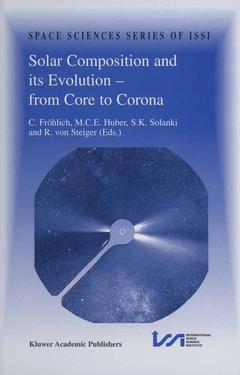Description
Solar Composition and its Evolution — from Core to Corona, 1998
Proceedings of an ISSI Workshop 26–30 January 1998, Bern, Switzerland
Space Sciences Series of ISSI Series, Vol. 5
Coordinators: Fröhlich Claus, Huber M., Solanki S.K., von Steiger Rudolf
Language: English
Subject for Solar Composition and its Evolution — from Core to Corona:
Keywords
Publication date: 10-2012
431 p. · 16x24 cm · Paperback
431 p. · 16x24 cm · Paperback
Description
/li>Contents
/li>
The discovery of chemical elements in celestial bodies and the first estimates of the chemical composition of the solar atmosphere were early results of Astrophysics - the subdiscipline of Astronomy that was originally concerned with the general laws of radiation and with spectroscopy. Following the initial quantitative abundance studies by Henry Norris Russell and by Cecilia Payne-Gaposchkin, a tremendous amount of theoretical, observa tional, laboratory and computational work led to a steadily improving body of knowledge of photospheric abundances - a body of knowledge that served to guide the theory of stellar evolution. Solar abundances determined from photospheric spectra, together with the very similar abundances determined from carbonaceous chondrites (where extensive information on isotopic composition is available as well), are nowadays the reference for all cosmic composition measures. Early astrophysical studies of the solar photospheric composition made use of atmosphere models and atomic data. Consistent abundances derived from different atmospheric layers and from lines of different strength helped to confirm and estab lish both models and atomic data, and eventually led to the now accepted, so-called "absolute" abundance values - which, for practical reasons, however, are usually given relative to the number of hydrogen nuclei.
Unveiling the Secrets of the Sun.- I: Solar Interior.- The ‘standard’ Sun.- Shortcomings of the Standard Solar Model.- Microphysics: Equation of State.- Opacity of Stellar Matter.- Element Settling in the Solar Interior.- Macroscopic Transport.- Solar Neutrinos.- Lithium Depletion in the Sun: A Study of Mixing Based on Hydrodynamical Simulations.- On the Velocity and Intensity Asymmetries of Solar p-mode Lines.- Sensitivity of Low-frequency Oscillations to Updated Solar Models.- Composition and Opacity in the Solar Interior.- Solar Models with Non-Standard Chemical Composition.- On the Composition of the Solar Interior.- II: Lower Solar Atmosphere.- Standard Solar Composition.- Structure of the Solar Photosphere.- The Structure of the Chromosphere.- The Solar Quiet Chromosphere-Corona Transition Region.- FIP Fractionation: Theory.- FIP Effect in the Solar Upper Atmosphere: Spectroscopic Results.- Constraints on the FIP Mechanisms from Solar Wind Abundance Data.- Element Separation in the Chromosphere.- Temporal Evolution of Artificial Solar Granules.- The Lower Solar Atmosphere.- III: Upper Solar Atmosphere and Solar Wind.- Elemental Abundances in Coronal Structures.- Structure of the Solar Wind and Compositional Variations.- The Solar Noble Gas Record in Lunar Samples and Meteorites.- Atomic Physics for Atmospheric Composition Measurements.- Solar Energetic Particles: Sampling Coronal Abundances.- UVCS/SOHO: The First Two Years.- The Expansion of Coronal Plumes in the Fast Solar Wind.- Fractionation of Si, Ne, and Mg Isotopes in the Solar Wind as Measured by SOHO/CELIAS/MTOF.- Solar EUV and UV Emission Line Observations Above a Polar Coronal Hole.- Solar Energetic Particle Isotopic Composition.- 05+ in High Speed Solar Wind Streams: SWICS/Ulysses Results.- Elementand Isotopic Fractionation in Closed Magnetic Structures.- Composition Aspects of the Upper Solar Atmosphere.- Is the Sun a Sun-like Star?.- Author Index.- List of Participants.
© 2024 LAVOISIER S.A.S.
These books may interest you

The Evolution of The Milky Way 158.24 €



